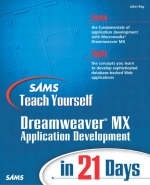
Sams Teach Yourself Macromedia Dreamweaver MX Application Development in 21 Days
Sams Publishing (Verlag)
978-0-672-32403-1 (ISBN)
- Titel ist leider vergriffen;
keine Neuauflage - Artikel merken
Sams Teach Yourself Dreamweaver X in 21 Days teaches the reader all the skills needed to learn how to effectively develop database-driven Web applications with Macromedia Dreamweaver X. The tutorial approach aids the reader in learning the basics quickly and then moves on to the more advanced features and concepts.
By the end of the 21 days, the reader will know how to create Web sites with dynamic content, develop a browser-based sales and inventory management system, create a discussion forum, develop a complete e-commerce solution, write custom validations and extend functionality with JavaScript, design enhanced navigation of the Web site, and make an informed decision as to which server platform is the right one for the project at hand.
John Ray is an award winning developer and technology consultant with more than 16 years of programming and administration experience. He has worked on projects for the FCC, The Ohio State University, Xerox, and the State of Florida, as well as serving as IT Director for a Columbus, Ohio-based design and application development company. John has written or contributed to more than 11 titles currently in print, including Mac OS X Unleashed.
(NOTE: Each chapter concludes with a Summary, Workshop, Q&A, Quiz, Quiz Answers and Exercises.)
Introduction.
Week 1 - At a Glance.
Day 1. Getting Started.
The Dreamweaver MX Interface. The Interface Components. The Document Window. The Insert Panel. The Properties Panel. The Menu System. The Other Windows and Panels. Getting Help. Customizing the Dreamweaver MX Preferences.
Day 2. Creating Your First Web Site.
Design Considerations. Creating Your First Web Site. Creating and Editing the Home Page. Adding Basic HTML Objects. Positioning with Tables. Other Important Functions.
Day 3. Advanced HTML and Site Tools.
Advanced Navigation. Advanced Layout and Document Control. Cascading Style Sheets. Customizing the Document Design Window. Forms: A Brief Introduction. Direct Access to the HTML. Site-Management Tools.
Day 4. Web Sites with Action-Client-Side Behaviors.
DHTML-What It Is and Isn't. Introducing Client Behaviors. Using Timelines. Instant Flash. Other Dynamic Elements. Advanced JavaScript Programming and Debugging.
Day 5. Creating Reusable Components.
Planning for Code Reuse. HTML Font Styles. Managing Site Assets. Working with Snippets. Recording Dreamweaver MX Commands. Creating a Distributed Editing Environment.
Day 6. Introduction to Dynamic Web Applications and Database Design.
Dynamic Web Sites. Understanding Dynamic Sites. Creating Dynamic Sites. Database Design.
Day 7. Preparing a Server for Dreamweaver MX.
The Dreamweaver MX Application Server. Choosing a Server. Creating an ASP Application Server on Windows XP. Creating a PHP Application Server on Mac OS X. Other Things You'll Need.
Week 1 - In Review.
Week 2 - At a Glance.
Day 8. Defining a Dynamic Site.
Interacting with the Application Server. Setting Up a Dynamic Site Definition. Database Connections. The Databases Panel.
Day 9. Introducing the Dreamweaver MX Dynamic Tools.
Traditional Databases on the Web. Standard Server Behaviors. Recordset Navigation Server Behaviors. User Authentication. Data Bindings.
Day 10. Creating Database-Driven Web Pages.
From Database to Web. A Table of a Table. Adding Graphics to the Recordset. Dynamic Attributes. Additional Functionality on Dynamic Screens.
Day 11. Storing, Editing, and Updating Data.
The Dreamweaver MX Application Framework. Creating an Input/Output System. Adding the Insert Behavior. Generating Detail Pages and Deleting Records. Creating Update Pages. Auto-Generating Forms and Pages.
Day 12. Writing Advanced Database Queries.
Why We Need SQL. The Database Objects. Creating Databases and Tables. Adding/Changing Data. Querying Database Tables. Other Advanced Techniques. Advanced Queries and Dreamweaver MX.
Day 13. Restricting User Access.
Login Systems. Login SQL and Passwords. A Simple Login. Maintaining a Session. Using Cookies. The Dreamweaver MX Authentication System. Real Web Site Security.
Day 14. Advanced Components: Catalogs, Searches.
A Product Catalog. Implementing the Application. Automating the Navigation Bar.
Week 2 - In Review.
Week 3 - At a Glance.
Day 15. Advanced Techniques: Static to Dynamic.
Making the Static to Dynamic Transition. Randomizing Banner Ads. Rotating Seasonal/Time-Based Images. Managing Multiple Seasonal/Time-Based Images. Getting Your User's Feedback.
Day 16. Applied Techniques: Data Collection and Reporting.
Input and Output, a Messaging System Overview. Building the Main List View (listing.asp). Reading Messages (view.asp). Creating the Composition Screen (compose.asp).
Day 17. Advanced Techniques: Tracking and Using User Data.
Customized Web Sites. Developing the Registration and Login System. Generating the Content Screen (content.asp). Finishing the Preferences (preferences.asp and storepref.asp).
Day 18. Advanced Techniques: Online Testing and Surveys.
Survey and Testing Systems. Building the Login Pages (login.asp and error.asp). Creating the Question Form (question.asp). Administrative Access.
Day 19. Advanced Techniques: Complex Query Systems.
Complex Searches. Complex Queries: Finding Your Perfect Match. Creating the Login System. Creating the Update Profile Page (profile.asp). Writing the Search and Results Pages (search.asp and results.asp). Protecting Your Pages.
Day 20. Testing and Deploying Dynamic Applications.
Coding Problems. Browser Issues. Validating Code. Finding Server Behavior Problems. Testing. Additional Troubleshooting Resources.
Day 21. Advanced Dreamweaver MX Features.
Advanced HTML Tools. Server Code. Dreamweaver MX Extensions. Customizing the Dreamweaver MX Environment.
Week 3 - In Review.
Appendixes.
Appendix A. Introduction to the Dreamweaver MX Languages.
Programming Concepts.
Appendix B. MySQL Quick Function Reference.
Common Data Types. Arithmetic Operations. Logical Operations. Basic Comparisons. String Comparison Functions. Mathematical Functions. String Functions. Date and Time Functions. Summarization Functions for Use with GROUP BY Clauses.
Appendix C. Dreamweaver MX CSS Style Reference.
Appendix D. Support Database Definitions.
Day 8. Day 10. Day 11. Day 12. Day 13. Day 14. Day 15: Banner. Day 15: Feedback. Day 15: Time Images. Day 16. Day 17. Day 18. Day 19.
Index.
| Erscheint lt. Verlag | 12.8.2002 |
|---|---|
| Verlagsort | Indianapolis |
| Sprache | englisch |
| Maße | 230 x 186 mm |
| Gewicht | 1179 g |
| Themenwelt | Mathematik / Informatik ► Informatik ► Grafik / Design |
| Mathematik / Informatik ► Informatik ► Web / Internet | |
| ISBN-10 | 0-672-32403-2 / 0672324032 |
| ISBN-13 | 978-0-672-32403-1 / 9780672324031 |
| Zustand | Neuware |
| Haben Sie eine Frage zum Produkt? |
aus dem Bereich


